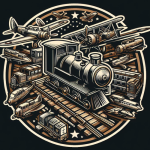Weathering is a vital step in bringing your model trains to life. It adds realism and depth to your miniature railroad, making it look more like the real thing. There are many different weathering techniques, but this step-by-step guide will give you a basic overview of how to weather your model trains.
Gather Your Supplies
Before you start weathering, it’s important to gather all the supplies you’ll need. These include:
- Paints: You’ll need a variety of paints to create a realistic weathering effect. This includes basic colours like black, brown, and grey, as well as pigments and weathering powders. Model paints
- Brushes: You’ll need a range of brushes, from small fine-tipped ones for detail work to larger ones for applying washes.
- Cotton swabs: These are useful for applying weathering powders and cleaning up mistakes. Model cotton swabs
- Q-tips: These are also helpful for applying weathering powders and cleaning up mistakes.
- Salt or sand: These can be used to create chipping and rust effects.
- Paper towels: These are for wiping away excess weathering.
- Weathering Powders: weathering powder pigments will give your models that realistic look.
- Water: This is used to thin paints and washes.
Preparation
The first step is to prepare your model train. This includes cleaning it thoroughly with soap and water, removing any loose paint, and sanding it lightly to roughen up the surface.
Applying a Base Coat
Once your model train is prepped, you can apply a base coat of paint. This will help to protect the model from the weathering effects and give you a solid surface to work with. Choose a paint that is close to the final color you want your model to be.
Washes
Washes are thin, diluted paints that are used to add shadows and depth to your model train. They are applied over the base coat and will settle into the cracks and crevices of the model, creating a realistic worn-out look.
To apply a wash, mix a small amount of paint with water until it is the consistency of milk. Then, use a small brush to apply the wash to the model, focusing on the areas that would be the dirtiest, such as around the wheels, undercarriage, and seams.
Chipping
Chipping is used to create the effect of paint that has chipped away, revealing the metal underneath. To simulate chipping, use a cocktail stick or a similar tool to chip away at the paint in small areas. You can then apply weathering powders or pigments to the chipped areas to make them look more realistic.
Rust
Rust can be added to your model train using various techniques, such as using rust-colored paints, weathering powders, or even salt or sand. To add rust using paint, simply mix a small amount of rust-colored paint with water until it is the consistency of a wash. Then, apply the wash to the areas where you want rust to appear.
Weathering Powders
Weathering powders are a great way to add a variety of weathering effects, such as dust, dirt, and rust. They are simply sprinkled on the model train and then dry brushed away to create a realistic effect.
Dry Brushing
Dry brushing is a technique used to highlight raised areas on the model train. It is done by using a brush with very little paint on it. The brush is then dragged across the model train, picking up paint from the high points and leaving a streak of color.
Cleaning Up
Once you are finished weathering your model train, you will need to clean up any excess weathering. This can be done with a cotton swab or Q-tip dipped in water.
Finishing Touches
Once your model train is dry, you can add any final touches, such as rust streaks or dirt marks. You can also use a sealant to protect the weathering.
Tips
- Use a variety of weathering techniques to create a realistic effect.
- Don’t be afraid to experiment!
- Be careful not to overdo it.
- Weathering should make your model train look more realistic, not like it was painted with a paintball gun.
